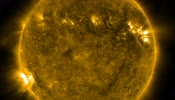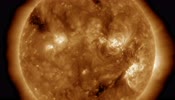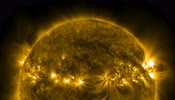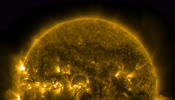Ultra HD Movies

- Magnificent Outburst
-
Sparked by a medium-sized (C-class) flare, a long, magnetic filament burst out from the Sun, producing one of the best shows that SDO has seen (Aug. 31, 2012). Viewed in the 304 Angstrom wavelength of extreme ultraviolet light, the filament strand gets stretched outwards until it finally breaks and heads off to the left. Some of the particles from this eruption did hit Earth with a glancing blow on Sept. 3, generating some beautiful aurora. The video clip covers four hours of activity.

- Magnificent Outburst
-
Sparked by a medium-sized (C-class) flare, a long, magnetic filament burst out from the Sun, producing one of the best shows that SDO has seen (Aug. 31, 2012). Viewed in the 304 Angstrom wavelength of extreme ultraviolet light, the filament strand gets stretched outwards until it finally breaks and heads off to the left. Some of the particles from this eruption did hit Earth with a glancing blow on Sept. 3, generating some beautiful aurora. The video clip covers four hours of activity.

- So Long
-
A long filament snaked across half the Sun this week (Jan. 19-23, 2014). This one, if it were straightened out, would be about 500,000 miles long. Filaments are elongated clouds of cooler gases, tethered above the solar surface by powerful magnetic forces. They are often unstable and prone to erupting, although so far this one has remained intact. The images, taken in extreme ultraviolet light, actually show ionized Helium at about 60,000 degrees C. Credit: Solar Dynamics Observatory/NASA.

- AIA 171 From July 2010
- Start Datetime: 2010-07-17 End Datetime: 2010-07-29 Channel/Wavelength: 0171

- Filament Eruption from August 2010
- Start Datetime: 2010-07-31 End Datetime: 2010-08-02 Channel/Wavelength: 0304

- Blossoming Blast
-
SDO observed a beautiful prominence eruption shot off the east limb (left side) of the Sun (April 16, 2012). Such eruptions are often associated with solar flares, and in this case an M1.7 class (medium-sized) flare did occur at the same time, though it was not aimed toward Earth. The movie (in extreme ultraviolet light) covers four hours of activity. As we have observed in some other events, some of the charged particles do not have enough force behind them to break away and they can be seen streaming back into the Sun.

- Large Clusters of Active Regions
- Start Datetime: 2017-09-04 End Datetime: 2017-09-10 Channel/Wavelength: 0193

- Interacting Active Regions
-
A series of active regions, lined up one after the other across the upper half of the Sun, twisted and interacted with each other over 4.5 days (Sept. 28 - Oct. 2, 2011). As seen in extreme UV light, the magnetically intense active regions sported coils of arcing loops and numerous times these magnetic field lines above them can be seen connecting with the active region next door. Towards the end of the clip, a leading active region blasted out a coronal mass ejection, quickly succeeded by a blast from another active region. The disruption of the magnetic field from one likely triggered the second, a phenomenon that we have observed before by SDO.

- Active Region Conga Line
-
A series of active regions were all lined up one after the other as they rotated into view over three days (Sept. 22-24, 2012). The gyrating loops above each of the regions seen in profile also add interest to the video clip and still image. Sometimes the magnetic field comes up into the corona from the lower regions and loops back down into the Sun. These were all taken in the 171 Angstrom wavelength of extreme ultraviolet light. Incidentally, the movie is comprised of over 460 images.

- Large Sunspot Groupings
- Start Datetime: 2017-09-04 End Datetime: 2017-09-10 Channel/Wavelength: HMII

- Five for Five
-
The Sun unleashed no less than five solar flares in five days this week all from the same dynamic active region (June 21-25, 2015). Many of these were associated with coronal mass ejections, most of which impacted Earth and generated beautiful auroral displays. The images were taken in a wavelength of extreme ultraviolet light. Flares are the bright flashes you see, followed by spirals of magnetic field lines as the active region reorganizes itself. Credit: Solar Dynamics Observatory, NASA.

- Quickly Developing Sunspot
-
This sunspot (AR2036) was barely visible three days ago and now it is about three or four times the size of Earth: that is a very impressive progression. This close-up video captures the action from SDO (Apr. 14-16, 2014) for about 2.5 days. Let's see if it produces any major solar storms.

- Four Large Flares in 48 Hours
-
A very energetic active region right at the Sun's edge blasted out four X-class flares (largest class) in two days (May 13-15, 2013), as well as several less flares. The active region is rotating around so that it will be facing Earth in about a week. The flares, observed in extreme UV light by the Solar Dynamics Observatory, are seen as bright flashes. They were: an X1.7 flare on May 13 at 02:21 UT; an X2.8 flare on May 13 at 16:07 UT; an X3.2 on May 14 at 01:46 UT; and an X1 on May 15 at 01:44 UT (see still).

- Flare Blowout
- Start Datetime: 2010-07-08 End Datetime: 2010-07-12 Channel/Wavelength: 0171